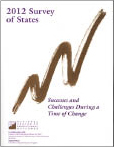 The 2012 Survey of States: Successes and Challenges During a Time of Change summarizes the thirteenth survey of states by NCEO. This report provides a snapshot of new initiatives, trends, accomplishments, and emerging issues.
The 2012 Survey of States: Successes and Challenges During a Time of Change summarizes the thirteenth survey of states by NCEO. This report provides a snapshot of new initiatives, trends, accomplishments, and emerging issues.
The survey was sent to state directors of special education and state directors of assessment, and completed by those individuals or their designee who had the best working knowledge of the state’s thinking, policies, and practices for including students with disabilities in assessment systems and other aspects of educational reform. In many states, teams completed the survey.
Key findings included:
- Fewer than half of the states have defined what college-and-career-readiness means for students with disabilities participating in the alternate assessment based on alternate achievement standards (AA-AAS).
- Fewer than half of the states offered their current general state assessments on computer-based platforms for math, reading, or science.
- State technology staff contributed to technology decision making for the AA-AAS being developed by the consortia in eight states, and contributed to technology decision making for the general assessment being developed by the consortia in just over half of the states.
- More than half of the states indicated a need for technology-related investments for the majority of districts in their state in order to improve the participation of students with disabilities in instructional activities and assessments. The types of investments most frequently cited as needed were additional computers and improved bandwidth for internet connectivity.
- More than three-quarters of the states considered universal design during test conceptualization and construction.
- Six states offered end-of-course alternate assessments based on AA-AAS.
- Fewer than half of the states included data for all students with disabilities in their teacher evaluation system for general education teachers.
- Twenty states did not disaggregate assessment results for English language learners with disabilities.
States commented on their greatest success and challenges during this time of change. They also identified the ways in which they prefer to receive technical assistance.
The report (PDF) is available at http://www.nceo.info/OnlinePubs/StateReports/2012StateSurvey.pdf
